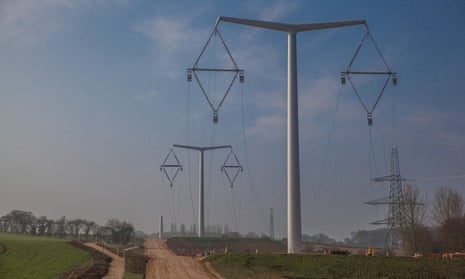They’ve marched tirelessly across the country for the last century, a 90,000-strong army of steel sentinels carrying electricity across hill and vale, gracefully suspended from their spindly frames. But now, the classic British pylon is facing extinction, thanks to a newcomer on the block: the whiter-than-white T-pylon, unveiled this week by the National Grid.
Designed by the Danish architecture and engineering firm Bystrup, the new pylon looks a bit like a ski lift mast adorned with two dangly diamond earrings, which hold three cables either side of the central pole.
Its creators say it is designed to have a reduced visual impact on the landscape: it has a smaller footprint than the traditional steel lattice pylon and is about a third lower in height than its skeletal forebears. It is also quicker to build. Prefabricated in bolt-together sections, it can be assembled by a team of five people in a day, compared with the nine people working for five days required for the original design.
Six of the new pylons have been erected at the National Grid’s training academy in Eakring, Nottinghamshire, each demonstrating a different function in the network – including the thrillingly named “F10 flying angle suspension pylon”, which can allow a turn of up to 10 degrees along the route.
“Our aim was to minimise visual impact and create a design that could adapt well to the English landscape,” said Brian Endahl, project manager at Bystrup, which won the project in a competition in 2011, beating rival designs based on everything from boomerangs to giant insects.
“We have built similar pylons in Denmark and found that the monopole structure works well in hilly areas as it requires less space and can follow the contours of the land.”
David Wright, director of electricity transmission asset management at the National Grid, said the new design was not intended as a replacement for the lattice pylon. “But it’s a new option and in some landscapes its shorter height and sleeker appearance can offer advantages,” he added.
The lattice pylon dates back to 1928, when the stridently anti-modern architect Reginald Blomfield selected a design by the American Milliken Brothers, which drew on classical proportions.
Blomfield chose the name “pylon” as a reference to the tapering gateways of ancient Egyptian temples, through which the energy of the human spirit was thought to pass into the afterlife, in an attempt to make the imposition of brute infrastructure more palatable.
But the first pylons sparked a backlash and were denounced in a letter to the Times signed by innumerable worthies, including Rudyard Kipling and John Maynard Keynes.
“In most people’s minds those pylons are still associated with the old industrial age of fossil fuels and pollution,” Endahl said. “With the move to renewables, we wanted our design to reflect the new era of clean energy.”
The T-pylon has the same wipe-clean white goods aesthetic as a wind turbine and, although it may be more compact than lattice pylons, it seems more chunky and clunky. The dark grey latticework structures dissolve into the background more than these fat white poles could ever do.
And for all the talk of being green, there’s a good deal more steel in the new design than in Blomfield’s wraith-like frames, which may soon go the same way as their gasometer cousins and become defunct relics of a bygone age.

Comments (…)
Sign in or create your Guardian account to join the discussion